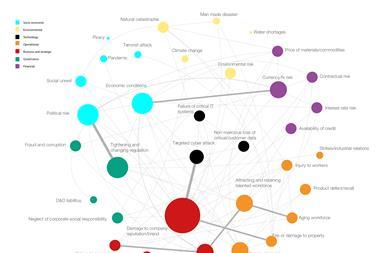Ahead of his speech at the Amrae conference 2020, Strategic Risk talks to Renaud de Pressigny, General Manager, QBE France, about the seismic changes facing the insurance sector and how the industry must adapt to the new world of risk
Risk management is changing, says Renaud de Pressigny, General Manager at QBE. Companies are becoming more international; they are coping with a wider array of risks and there is a lot more volatility.
As a result, the insurance sector has needed to adapt quickly to work with risk managers to meet their evolving needs. Pressigny explains: “Traditional insurance products alone cannot fully meet the needs of organisations, particularly when it comes to non-tangible risks.

“Some of these risks are very difficult to assess, difficult to quantify and where the indemnification process would be hazardous, best avoided.”
As insurers and brokers have recognised the increasing importance of uninsurable risks, most have responded by broadening their scope of business and using their skills and knowledge to help customers improve their risk profiles.
Pressigny said: “At the end of the day this is good for both the insurers and the insureds. Risk managers reduce the risks facing the businesses, there are fewer claims and as a result their premiums come down. Meanwhile, insurance companies and brokers can better serve the needs of clients and stay relevant.”
“Providing these new risk management services is a great way to get to know the customer, and selling those services as an add-on to insurance may work well as a revenue stream.”
This approach has had significant impacts on the way insurance companies are operating, not least because it has fundamentally changed the relationship between risk managers and their insurers.
Pressigny explained: “It’s good for insurance companies because it increases the number of touchpoints with a client. Typically, with a mid-sized corporate client, you’d only have a few interactions with the insurance manager each year, perhaps sending a bill and processing a couple of claims. Providing these new risk management services is a great way to get to know the customer, and selling those services as an add-on to insurance may work well as a revenue stream.”
In turn, risk managers are keen to adopt more of a partnership approach. As the ‘to do’ list grows, those responsible for risk and insurance have a growing number of threats to keep pace with and much more regulatory admin to manage. And as the risk function professionalises, many risk managers are demanding more data, knowledge and transparency from their insurers.
Pressigny says: “It has evolved over the years. Risk managers want their companies to be seen as a whole and are looking for an insurance partner that truly understands their business. They want to build a long-term, often global, relationship – with the support of their brokers.
“They are saying: ‘some of my risks are pretty good, some are not yet at the optimal level. I want you to support me not only for the best risks but also for the more challenging ones.’ They expect insurers to understand the business model, changes in product lines and mix, and how their risk profile is changing.
”Risk managers want their companies to be seen as a whole and are looking for an insurance partner that truly understands their business. ”
“This is even truer in a hardening market. They can justify a price increase but only if there is transparency about why it is happening that they can present to a board. They want benchmarks, they want to understand how the risk is priced, they expect the same quality internationally, they want more data and information and they want advice on emerging risks.”
While the insurance sector has made some strides in adapting to the needs and demands of the modern risk manager, it still has some way to go. Pressigny highlights data science, multinational programmes and operational efficiency as the three areas insurers must continue to improve on.
He concludes: “Our ability to harness and share data with our customers is key. We don’t use it as well as we could internally and do not share it externally as much as we could. The whole aim of big data is to understand and price risk better, to share insights with clients and to learn from claims trends and experiences in similar markets and industries.
“The second thing to work on is operational efficiency. We are often seen as being inefficient – especially when risk managers look at our expense ratios. We need to delegate tasks when it makes sense to do so, as the value chain is still seen as too complex and too cumbersome.
“The third area that needs improvement is the ability to work globally. The sector has made tremendous progress to cover corporates around the world, but it is not yet good enough. Despite complex local and international regulations, we need to achieve better consistency of coverage and real-time information flow and consolidation of data from all points of the globe.”




















No comments yet